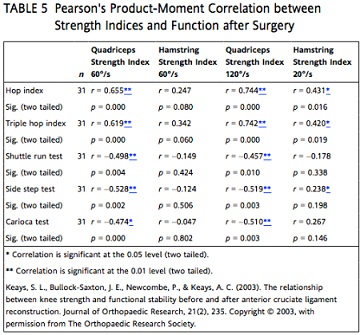Discuss the below:
Q1. What is the r value for the relationship between Hamstring strength index 60°/s and the Shuttle run test? Is this r value significant? Provide a rationale for your answer.
Q2. Consider r = 1.00 and r = -1.00. Which r value is stronger? Provide a rationale for your answer.
Q3. Describe the direction of the relationship between the Hamstring strength index 60°/s and the Shuttle run test.
Q4. Without using numbers, describe the relationship between the Hamstring strength index 120°/s and the Triple hop index.
Q5. Which variable has the weakest relationship with the Quadriceps strength index 120°/s? Provide a rationale for your answer.
Q6. Which of the following sets of variables has the strongest relationship?
a. Hamstring strength index 120°/s and the Hop index
b. Quadriceps strength index 60°/s and the Carioca test
c. Quadriceps strength index 120°/s and the Side step test
d. Quadriceps strength index 60°/s and the Triple hop index
Q7. In Table , two r values are reported as r = -0.498 and r = -0.528. Describe each r value in words, indicating which would be more statistically significant, and provide a rationale for your answer.
Q8. The researchers stated that the study showed a positive, significant correlation between Quadriceps strength indices and pre- and postoperative functional stability. Considering the data presented in the Table 5, do you agree with their statement? Provide a rationale for your answer.
Q9. The researchers stated that no significant relationship could be described between Hamstring strength indices 60°/s and functional stability. Given the data in Table 5, explain why not.
Q10. Consider the relationship reported for the Quadriceps strength index 120°/s and the Hop index (r = 0.744**, p = 0.000). What do these r and p values indicate related to statistical significance and clinical importance?
